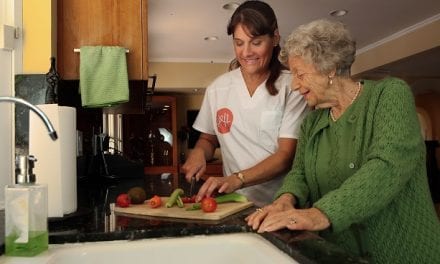Does your residents’ dining experience deteriorate as they move from independent living, to assisted living, to memory care or skilled nursing?
By Pam McDonald
In some senior living communities (I hope not yours), the quality of the dining experience deteriorates as residents move from independent living to assisted living, to memory care or skilled nursing.
David C. Koelling, President of Strategic Dining Services, an integrated, hospitality-based dining management company, and Senior Housing Forum partner, says this does not have to be the case nor should it be.
Creating A Culture of Excellence
He says, “A community with a culture of excellence will take the steps necessary to deliver fresh, healthy, interesting to eat food, exceptional service, and hospitality to all residents – regardless of their level of care.”
He points out, “As residents go through the continuum of care, their costs typically go up. The dining experience should not get worse.”
David also notes that maintaining higher standards is easier in independent and in assisted living when the food is plated in the kitchen with chef supervision and served by dedicated dining room servers. He says, “However, excellence and attention to dining experience details should be a priority across the board.”
Poor Design Can Have A Large Impact
Unfortunately, the design of many communities separates the kitchen from various dining areas, particularly in assisted living and memory care. Often meals have to be transported from the kitchen to a serving station.
David says, “When meals are not served directly from the kitchen, there is an immediate degradation of quality. The food is not nearly as good as when it comes off the production line directly onto the plate. Therefore, food prep, temperatures, plate presentation, and an overall commitment to quality need extra attention.”
Service Can Suffer Without Proper Training
Service, too, can suffer when it is turned over to care staff or universal workers, which is often the case in memory care and skilled nursing. “Typically, they’re not trained in dining and hospitality and are unlikely to have the same investment in the dining experience as the culinary and dedicated dining services staff,” David says.
An example of how service can break down is when a resident doesn’t want the entrée(s) being served. David says, “The server may not have alternatives to offer. But asking the chef for something else is difficult given the lack of time or the kitchen may push back from producing something special during AL/IL service. So, servers simply plate and serve the food, hoping for the best. Weight loss can quickly become an issue.”
Small Modifications Can Make A Huge Difference
But, he notes that small modifications in the plating area can make a huge difference. He recommends:
-
Finding a permanent place for plating.
-
Having a small refrigerator, multiple-use oven, and panini press available.
-
Carrying a minimum of 12 “always available” food items, such as eggs, chicken or egg salad, slices of ham, tomatoes, pickles, and a fruit plate.
David says, “This feels more like independent living and enables serving staff to respond to residents needs and desires. It sends the message ‘we care’ to residents and families, and fulfills staffs’ aspiration to be part of something excellent. Finding ways to create a culture of ‘yes’ to residents’ requests goes a long way to resident, family, and employee satisfaction.”
The Fundamentals of Hospitality
David believes food service excellence starts with fresh ingredients that dedicated food preparers then transform into creative, health-promoting meals. He believes the keys to success are training and accountability. Demonstrating the same commitment to the dining experience in all care levels gives the service staff an increased level of understanding and awareness for creating the best possible dining experience.
He recommends all care staff receive training in the fundamentals of hospitality. Additionally, any staff – regardless of their job title – who may serve residents and guests undergo an additional 30-minutes in plating and serving. Tutorials can be arranged as needed.
He also believes that each day servers should gather for 3-5 minutes with the dining director, the head chef, or wait staff supervisor to review meals for the day and discuss plating as well as tips for service. “This will dramatically increase hospitality, as well as build confidence in performance,” he says.
David states, “There should be accountability of servers and that means Food Services managers should be in the dining room observing, as should Directors of Memory Care and Executive Directors. Observing, coaching, pouring a cup of coffee or two, and pitching in shows that commitment to excellence starts at the top.
“Ultimately,” he concludes, “leadership in each community has responsibility for maintaining high standards for every level of care.”
If you’re interested in ensuring your residents enjoy an exceptional dining experience, contact Strategic Dining Services. Visit their website by clicking the button below or call (888) 406-1902.
Click on the button below to download a PDF copy of this article:









